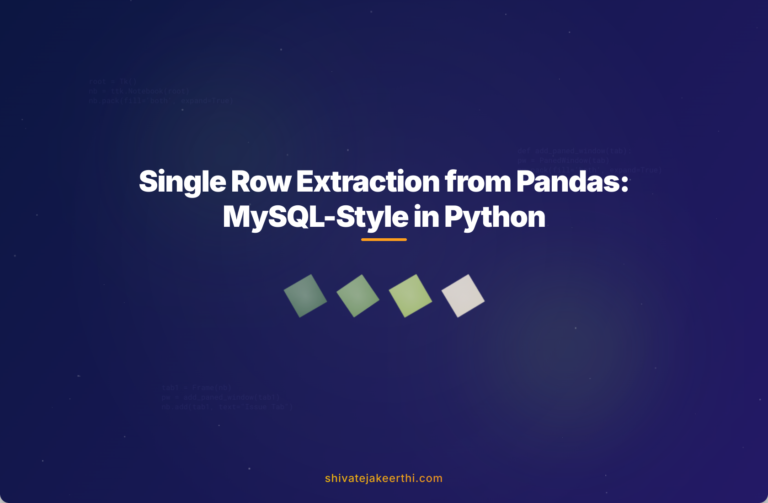Returning a single row from a Pandas DataFrame might seem straightforward, but it often puzzles developers accustomed to the simplicity of MySQL queries. In MySQL, you likely got used to quickly retrieving a specific row using straightforward commands like SELECT with a LIMIT clause. Pandas, however, requires a slightly different approach due to its Python-native structure.
Understanding the differences between the two systems and knowing how to replicate MySQL-type queries in Pandas is essential, especially when managing data analysis workflows in Python.
What Exactly is a Pandas DataFrame?
Think of a DataFrame as a table you interact with daily, much like an Excel spreadsheet or an SQL table. Each column can have its own data type—numeric, text, date-time, and so forth—while rows contain the actual data points. This structure makes DataFrames incredibly flexible and intuitive for data management tasks, similar to MySQL tables but optimized for Python.
While MySQL provides SQL (Structured Query Language) commands to directly fetch single rows quickly, Pandas relies on indexing and iterative methods. Let’s break down how you can replicate typical MySQL query behavior to fetch and print a single row value from a DataFrame.
Setting Up the Environment and Loading Data
Just like setting up your ingredients before cooking, the first step is importing the necessary libraries and loading your dataset. For this task, you’ll mainly use Pandas, the popular Python library for data analysis.
Here’s how you start by importing libraries:
import pandas as pd
import requests
Next, let’s load a dataset hosted on Google Docs. Typically, you’d use CSV files or databases, but here we demonstrate fetching directly from a Google Docs URL:
# Load data from Google Docs URL
url = "https://docs.google.com/spreadsheets/d//export?format=csv"
response = requests.get(url)
data = pd.read_csv(pd.compat.StringIO(response.text))
Replace
Preprocessing Your Data for Analysis
Before you retrieve a specific row, consider preprocessing your DataFrame. One common step is sorting your data based on selected columns, ensuring consistency:
# Sorting data by a specific column, e.g., 'sales'
data_sorted = data.sort_values(by='sales', ascending=False).reset_index(drop=True)
Preprocessing like sorting helps organize data effectively, making it easier for further analysis. Another preprocessing technique includes identifying maximum values in rows or columns if needed.
# Finding maximum values for row and column counts
max_row, max_col = data_sorted.shape
print(f"Data has {max_row} rows and {max_col} columns.")
Finding and Retrieving a Single Row in a Pandas DataFrame
Suppose you want to fetch a single row by a specific condition, such as retrieving the row where sales are at their maximum:
# Retrieve row with maximum sales
max_sales_row = data_sorted.iloc[0]
# Print the row
print(max_sales_row)
Here, the iloc method selects the first row after sorting, ensuring you get the highest sales record.
Alternatively, you can fetch a single row based on a conditional query, similar to MySQL’s WHERE clause:
# Retrieve row by condition
specific_row = data_sorted[data_sorted['product'] == 'Laptop Model X'].iloc[0]
# Print the row
print(specific_row)
You can adapt the conditional statement to match exactly what you need, mirroring MySQL’s querying capabilities.
Testing & Evaluating Your Results
Always test your code with sample data before scaling to complete datasets. Here’s a quick way to visualize your test results clearly:
# Testing on small sample
print(data_sorted.head(5))
Reviewing this sample output quickly verifies sorting correctness and data integrity:
- Are the top rows what you expected?
- Is the sorting correct?
- Did the conditional fetch correctly return your desired data?
Evaluating these quick tests helps confirm your data analysis steps are accurate. Additionally, ensure you handle data types properly to avoid unexpected behavior during querying and fetching.
Comparing Pandas vs. MySQL Queries
Developers familiar with MySQL queries might initially find Pandas data selection methods unusual. Here’s how retrieving a specific row compares between Pandas and MySQL:
| Operation | MySQL Query | Pandas Equivalent |
| Select single row by condition | SELECT * FROM table WHERE id = 1 LIMIT 1; |
df.loc[df['id'] == 1].iloc[0] |
| Select first row | SELECT * FROM table LIMIT 1; |
df.iloc[0] |
Both tools have pros and cons:
- Pandas Pros: Integrated Python ecosystem, easy data manipulation, extensive data analysis capabilities.
- Pandas Cons: Memory intensive on large datasets, requires manual indexing/sorting.
- MySQL Pros: Optimized queries, suitable for larger datasets, indexing speeds up searching.
- MySQL Cons: Adds complexity when integrated into Python scripts.
Choosing Pandas or MySQL thus depends heavily on your task and data size.
Printing a Value from a Row in Pandas
After fetching your single row, printing values from it is easy. Let’s say you want to print just the ‘sales’ value from your retrieved row:
# Print sales value
print(f"Sales value: {max_sales_row['sales']}")
Alternatively, you could access the value using the column index number:
# Access by column index
print(f"First column value: {max_sales_row.iloc[0]}")
Both methods let you customize exactly how you present the data, making data analysis presentations clearer and more useful.
Additional Methods to Retrieve or Print Values
Pandas offers various flexible methods to extract or print values efficiently:
- Using loc: Retrieves rows based on labels or conditions.
- Using query(): Allows SQL-like queries for convenient filtering.
- Using at[] and iat[]: Retrieves single values directly using labels or positional indices.
Exploring these methods further simplifies your workflow, especially with large or complex datasets.
Returning a single row from a Pandas DataFrame may require a slight adjustment if you’re familiar with MySQL queries. Yet, Pandas offers flexibility and power unmatched when integrated within Python scripts, particularly for data analysis tasks.
By understanding how to preprocess, select, and print data effectively, you streamline your workflow and improve your efficiency significantly.
If you’re interested in mastering more Python skills or have specific questions, check out other Python tutorials for detailed explanations and tips.
Do you find it easier working with Pandas or MySQL when handling analytics tasks? Let me know what works best for you!



0 Comments